
Store
$0.00











L.O.O.K.
is
the
acronym
for
our
newest
endeavour.
It
stands
for
LOVE:
Orphan
Outreach
for
Kids.
We
have
several
ongoing
projects
happening
at
the
same
time.
They
all
have
to
do
with
AIDS
orphans
in
other
countries.
I
will
explain
each
of
the
projects
so
you
can
understand
the
sphere
of
influence
that
young
people
can
have
in
our
world today. It is very exciting!!
This
first
orphan
project
came
about
serendipitously
when
a
friend
told
me
she
and
her
daughter
were
going
on
a
missionary
trip
to
Tanzania.
They
would
be
going
to
help
at
an
orphanage
in
Moshi
called
KIWAKKUKI.
She
asked
if
I
would
like
her
to
take
some
plain
dolls
in
case
there
were
HIV+
women
who
wanted
to
make
some.
I
heartily agreed.
What
happened
in
the
meantime
was
nothing
short
of
a
miracle.
Because
of
time
constraints
another
woman,
Trish,
who
lives
at
the
orphanage,
took
over
administering
the
doll
project.
She
purchased
tribal
cloth
for
the
clothing
of
the
dolls,
to
make
sure
they
reflected
the
heritage
of
these
people.
Then
she
worked
with
one
psychosocial group that was having some problems. Following is an excerpt from an email that Trish sent:
The
orphanage
is
what
would
be
considered,
very
under-funded,
but
relatively
loving.
The
caretakers
are
relatively
few
and
very
young,
and
most
are
orphans
themselves,
but
they
are
very
enthusiastic
to
learn.
The
program
started
when
one
of
the
Norwegian
benefactors
at
KIWAKKUKI
relayed
information
to
the
orphan
support
program
that
they
felt
that
the
issues
of
psychosocial
care
were
not
being
addressed
well
enough
by
KIWAKKUKI
and
most
other
AIDS
organizations
in
the
Tanzanian
(and
indeed
in
Africa)
areas.
The
children
were
dealing
with
the
trauma
of
the
death
of
their
parents,
and
yet
being
expected
to
be
grateful
that
they
had
a
roof
over
their
heads
and
that
for
most,
their
school
fees
were
paid.
So
the
benefactors
requested
that
KIWAKKUKI
do
a
study
of
orphans
in
different
areas
of
Moshi
to
identify
issues
that
the
caregivers
had
and
issues
that
the
children
had.
They
found
interesting
results,
not
rocket
science, but for both groups somewhat of a surprise and conundrum.
They
found
that
the
caregivers
were
exhausted,
overworked
and
overwhelmed.
The
caregivers
reported
that
the
children
were
disrespectful,
ran
away
from
school,
screamed
in
the
night,
and
generally
wore
them
out
even
more.
The
caregivers
reported
that
they
scraped
to
just
feed
the
family,
and
that
they
just
couldn't
take
any-more.
The
children
reported
that
they
were
tortured
at
school
about
their
parents
dying
of
AIDS,
that
they
were
taunted
and
that
fights
were
picked,
so
it
was
much
easier
to
run
away.
Even
their
teachers
picked
on
them,
they
stated.
They
said
that
they
were
frightened
particularly
at
night
because
the
ghosts
of
their
dead
parents
appeared
before
them
when
they
were
in
bed
and
asked
them
-where
are
you?,
why
did
you
leave
me?,
I
miss
you
etc.
It
was
very
frightening
and
caused
them
to
wet
their
beds,
to
scream, and to be unable to sleep at night so that they were exhausted, terrified and dirty in the morning.
The
program
formed
its
goals,
based
on
the
8
principles
of
international
child
development
(ICDP)
which
included,
hugging,
talking,
touching,
teaching
respect
and
playing.
The
volunteer
leaders
were
trained
for
3
weeks
in
facilitating
these
trainings.
Then
the
groups
were
formed
in
different
areas
of
town.
Children
for
the
most
part
were
separated
from
the
caregivers,
and
had
time
to
talk
about
the
issues
they
were
having,
and
with
the
help
of
the
facilitators
were
forming
plans
on
how
they
could
give
better
care
to
one
another
without
causing
further
exhaustion.
Just
simple
things
like
teaching
both
boys
and
girls
to
cook
some
of
the
traditional
dishes
and
sing
traditional
songs
and
games
etc.,
that
wouldn't
take
time,
to
do
things
like
when the children wound up screaming to take them into bed with them or let them sleep near them etc.
They
brought
in
the
teachers
and
worked
with
teachers
on
AIDS
education,
treating
children
equally
and
helping
the
children
with
problems
to
become
part
of
the
group,
also
tolerating
one
another
and
breaking
up
fights.
They
were
told
that
they
should
report
when
children
were
coming
to
school
with
no
shoes,
ragged clothes (more ragged than usual) or not coming to school at all.
So
at
the
end
of
the
training
sessions,
the
children
and
caregivers
were
re-surveyed
and
both
groups
reported
that
things
generally
were
better.
The
children
found
that
they
loved
learning
the
traditions
of
their
tribes,
and
the
caregivers
found
that
the
children
liked
helping
them.
The
children
were
having
fewer
nightmares
and
when
they
did,
the
caregivers
were
sharing
the
little
space
that
they
had
so
that
they
could
sleep.
They
stopped
wetting
the
beds,
and
screaming.
Everyone
got
more
sleep,
and
though
there
were
still
a
lot
of
glitches;
most
especially
related
to
poverty,
not
enough
food,
kids
around
to
sell
the
boys
esp. marijuana and trying to get the girls in the sack, that things were generally better.
Teachers
were
very
appreciative
of
training
regarding
HIV/AIDS.
There
are
many
myths
in
Africa
about
it
and
the
teachers
are
generally
young
women
who
have
just
graduated
from
secondary
school
themselves, hardly prepared to deal with psychologically disturbed orphans.
Anyway,
these
pictures
are
just
one
of
the
psychosocial
groups.
They
have
been
meeting
about
once/month
to
discuss
the
issues
that
most
concern
them.
Most
of
the
time
they
meet
separately,
but
they
always
come
together
for
a
soda
and
cake
at
the
end.
It
was
very
moving.
The
children
loved
the
doll
making.
Some
of
them
worked
so
hard
on
their
dolls,
and
we
didn't
have
enough
needles
and
thread,
and
many
of
the
children
weren't
old
enough
to
use
a
needle,
but
they
made
dolls
of
their
fathers
and
mothers,
and
also
of
course
samurai
warriors
as
well.
The
girls
wanted
to
make
dolls
that
would
show
the
way
they
would be when they got older.
So
that
is
the
story
as
best
as
I
can
tell.
And
you
are
most
welcome
to
add
the
KIWAKKUKI
children
to
the
project.
They
would
be
thrilled.
I
will
send
you
their
stories
as
well.
They
are
rather
self-
explanatory
with
the lifelines showing quite clearly when parents died. It is moving.
Thanks for your interest.
Trisha
So
you
see,
the
orphans
loved
making
the
dolls
and
kept
them
to
remind
them
of
their
parents.
What
a
wonderful
way
to
help
heal
the
lives
of
these
unfortunate
children.
On
these
pages
you
will
see
pictures
of
these
children
and
you
will
read
their
handwritten
biographies,
most
with
time
lines
of
their
lives.
They
were
written
in
Swahili,
their
native
language,
so
we
have
translated
them
into
English
so
that
others
may
understand
these
children’s
words.
The
second
orphan
project
is
with
a
new
orphanage
that
is
opening
in
Honduras.
It
is
called
Walking
With
Children.
The
facility
houses
children
living
with
HIV
infection
so
that
they
can
get
proper
care.
STITCHES
Doll
Project
is
currently
seeking
grant
money
to
fund
a
training
mission
to
Honduras.
Our
plan
is
to
train
volunteers
and
local
women
to
plan
and
implement
a
doll-making
workshop.
In
this
way,
they
can
continue
to
empower
girls
and
women
who
are
living
with
HIV
infection.
The
facilitators
will
take
pictures
of
the
dolls
that
we
will
then
post
on the STITCHES website for all to see and learn from.
At
present
we
are
making
beautiful
traditional
jewellery
with
beads
made
from
Honduran
river
clay.
We
get
the
beads
directly
from
the
women
that
make
them
by
hand,
then,
our
STITCHES
volunteers
make
them
into
different
jewellery
items.
We
will
sell
these
pieces
at
displays,
fund-raisers
and
on
our
website,
and
share
the
profits
with
Walking
With
Children.
This
will
help
raise
the
awareness
of
the
plight
of
the
orphans
in
Honduras,
raise needed money, and forges a great working relationship between the orphanage and our organization.
The
caveat
to
this
is
something
wonderful
that
happened
when
I
told
this
story
to
some
middle
school
girls
in
inner-city
Detroit.
I
had
been
requested
to
bring
some
dolls
to
Durfee
Middle
School
on
the
west
side.
The
girls
loved
looking
at
the
dolls
and
hearing
each
of
their
moving
stories.
Then
they
asked
lots
of
questions
about
AIDS
and
sex
in
general.
You
could
see
that
they
were
hungry
for
good
information.
Upon
hearing
about
my
involvement
with
these
orphans,
the
girls
also
wanted
to
do
something
tangible.
A
few
weeks
went
by
and
their
teacher
contacted
me
to
say
that
she
had
a
gift
for
me
from
the
girls.
When
she
arrived
she
presented
me
with
14
colourful
dolls,
handmade
by
the
Durfee
girls.
Each
one
had
a
message
of
love
and
hope
attached
to
it
is“
for
the
orphans
in
Honduras.
Needless
to
say,
it
brought
me
to
tears.
A
month
later
I
met
with
the
Director
of
Walking
With
Children
while
she
was
in
Michigan
for
a
fund-raising
mission.
I
presented
her
with
the
the
Durfee
Dolls
and
a huge bag of brand new socks for the children. She was as overwhelmed.
Because
there
is
such
an
interest
by
young
people
to
get
involved
in
this
work,
we
have
developed
several
other
workshop
sessions
that
we
offer.
Our
resident
artiste,
Gloria,
designed
beaded
doll
pins
made
on
wire.
These
are
fun
to
make
for
people
of
all
ages.
We
then
sell
these
at
local
events
and
on
our
website
to
raise
money.
Each
doll
pin
is
unique
and
colorful.
They
can
be
worn
on
a
lapel,
used
as
a
sun
catcher,
or
hung
from
a
rear
view
mirror.
The
other
workshop
ideas
involve
sock
puppets,
made
from
socks
and
small
pillows
made
with
scrap
materials.
These
are
very
simple
craft
projects
that
kids
and
adults
of
all
ages
can
take
part
in.
Once
they
are
finished
we
send
these
creations
to
the
orphanages
to
bring
fun,
love,
and
entertainment
into
their
lives.
It
lets
the
orphans
know
that
other
children
of
the
world
care
about
them.
And
it
teaches
our
children
here
how
blessed
they
are
to
live in this country and have the resources that are available to them.
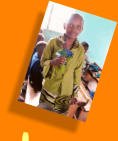
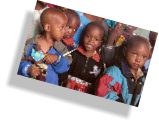

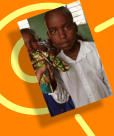
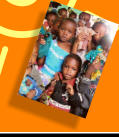
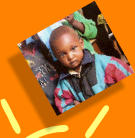

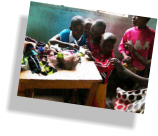
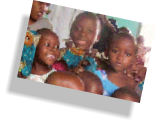












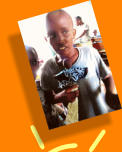
STITCHES
ORPHAN PROJECT
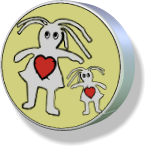
STITCHES Womens Iniaitives 28056 Palomino Drive
Warren, MI 48093 Phone: 586-873-8034








